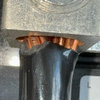NEC par. 210.52 incomplete?
kaseki
16 years ago
Sponsored
Columbus Area's Luxury Design Build Firm | 17x Best of Houzz Winner!
More Discussions
I have a kitchen plan that includes a counter extending along a seven-foot wide bay window in an exterior wall. The counter top height and window sill height are to be the same, with the intent that the counter top extend into the window. As a result, the NEC par. 210.52 two-foot rule cannot be met by receptacles in the wall space above the counter except at the sides of the window. Face-up receptacles in the counter are prohibited in a later part of the NEC for good reason.
Exceptions in NEC par. 210.52 (C)(5) do not literally apply, unless one takes the position that a window is not a wall and hence the counter is a peninsula. In this case, additional outlets could be put below the counter top on the cabinet face.
I am unclear whether such an attempt at meeting the intent of the rule while violating its exact wording would be acceptable to my local building inspector. Before I raise the question with him, I would like to know if this is a settled issue, or at least what is typically done in such cases.
Thanks for any help
kas



bus_driver
normel
itsunclebill
bus_driver
brickeyee
petey_racer
cobraguy
kasekiOriginal Author